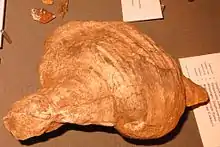Gigantoproductus giganteus
Gigantoproductus giganteus is an extinct species of brachiopods in the family Monticuliferidae, known only from its fossil remains. It was a marine invertebrate found on the seabed in shallow seas. It probably evolved during the Devonian period and it is believed to be the largest brachiopod that has ever existed.[1]
| Gigantoproductus giganteus | |
|---|---|
 | |
| Scientific classification | |
| Kingdom: | |
| Phylum: | |
| Class: | |
| Order: | |
| Family: | †Monticuliferidae |
| Genus: | |
| Species: | †G. giganteus |
| Binomial name | |
| †Gigantoproductus giganteus (Sowerby, 1822)[1] | |
Description
Gigantoproductus giganteus was a large brachiopod that superficially resembled a cockle. Fossils of this species have been found with widths of over 30 centimetres (12 in). It had a pair of thick dome-shaped valves joined together by a hinge. The valves had a small number of broad ribs that radiated from a thick umbo and there were large wing-shaped ears of calcareous material on either side. The valves were held together by a central strong adductor muscle which left a scar on the inside of the valves. The ventral valve, also known as the pedicle, was covered with spines on the outside. The inside of this valve was rough, being covered by numerous cone-shaped protrusions.[2] These are visible in an internal mould of the brachiopod, a cast fossil which has been formed when a hole in sediment left by the soft tissues of the dead organism was later infiltrated by mineral matter.[3]
Distribution and habitat
The fossil record suggests that Gigantoproductus giganteus was common between about 345 and 328 million years ago. Fossils have been found in Europe, Asia and North Africa.[1] The morphology of the shell makes it likely that it lived on the seabed, partially buried in sand or mud, in shallow water in locations with strong waves and currents. Here its large size, its heavy weight, its ears and spines would have helped provide stability, preventing it from rolling around.[4]
Biology
Like other brachiopods, Gigantoproductus giganteus was a filter feeder, using its lophophore, a specialist feeding organ, to extract planktonic particles from the water. Reproduction was likely to have involved release of gametes into the water column.[1] Gigantoproductus giganteus, like the vast majority of other brachiopod species, may have become extinct after a catastrophic event known as the Permian–Triassic extinction event which occurred about 252 million years ago.[5]
References
- Lee Davies. "Gigantoproductus giganteus". Natural History Museum. Retrieved 2013-02-21.
- Tom Yancey. "Gigantoproductus giganteus (Sowerby, 1822)". Carboniferous fossils of Russia. Retrieved 2013-02-21.
- Megan Beckett. "Fossils: Fossil types". Siyavula: Life Sciences Grade 10. Retrieved 2013-02-23.
- Ferguson, J. (1978). "Some aspects of the ecology and growth of the carboniferous gigantoproductids". Proceedings of the Yorkshire Geological Society. 42: 41–54. doi:10.1144/pygs.42.1.41.
- Leighton, L.R.; Schneider, C. L. (2008). "Taxon characteristics that promote survivorship through the Permian–Triassic interval: transition from the Paleozoic to the Mesozoic brachiopod fauna". Paleobiology. 34 (1): 65–79. doi:10.1666/06082.1.